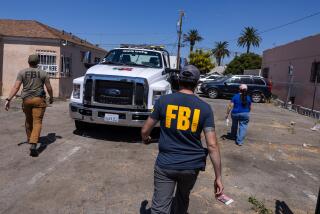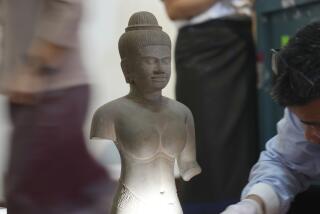Cambodian Relics Disappearing
- Share via
SIEM REAP, Cambodia — Thai police had good reason to be suspicious of the 10-wheel truck that lumbered across the Cambodian border one afternoon in January headed for their capital, Bangkok.
For one thing, the two men in the cab were unusually scruffy and looked dust-covered, as if they had been working in a quarry. For another, the truck was carrying such a heavy load that its tires were nearly flat.
What the police found inside was a priceless treasure: an entire sandstone wall from the 10th century Banteay Chhmar temple in a remote corner of northwest Cambodia. It had been skillfully cut into 119 pieces, each carefully numbered for eventual reassembly.
The devastation of the temple was another sad reminder that the ancient temples of Cambodia--particularly those in the Angkor Wat complex here--are under siege by gangs of organized bandits that often include army soldiers and military brass. Most of the ancient relics find their way to shops in Bangkok frequented by Western collectors.
Although pillaging is nearly as old as the temples themselves, antiquity specialists say the theft of Buddha heads, lintels, bas-reliefs and sandstone walls has reached epidemic levels in recent months, partly because of the regional economic crisis. The downturn has reduced living standards and heightened the temptation of thievery in which a Buddha head might fetch several thousand dollars from a collector.
“The small Buddha head that was here disappeared sometime in the past two weeks,” said Sor Vathana, a researcher with the government’s Department of Antiquities, pointing to a desecrated wall in the Kroal Kor temple. “As you can see, this was a crude job. They just hammered out the head with a chisel. Usually, they’re much more sophisticated.”
Police investigators say about 10 freelance gangs work in the 15-square-mile Angkor area. Until Angkor was occupied by the Thais in 1431 and eventually abandoned, the city was the seat of power of the Khmer Empire, whose influence stretched over half of Southeast Asia for several centuries. Its complex of palaces and temples is often compared in splendor to Machu Picchu, Peru’s “lost” Incan city.
The Angkor temples are off limits between sunset and dawn, but the bandits have little difficulty entering the complex at night--despite the presence of 400 temple guards who earn $15 each a month and are sometimes paid to look the other way. The bandits know exactly what ancient piece they are after, investigators say. They work with saws, drills, hammers and chisels.
“It’s like cutting a diamond,” said Uong Von, the Siem Reap representative for the Antiquities Department. “If the stone cracks or splinters, the piece is going to lose its value. These people have skill, and they know what they are doing.
“Sometimes the pieces are carted out by oxcart, sometimes in army trucks. The smuggling is very well organized. And certainly there’s no doubt that top [military] brass are involved.”
Throughout the Angkor complex, hundreds of headless or limbless statues stand as silent symbols of the looting and destruction that have taken place here since 1860, when Henri Mouhot, a French naturalist, discovered the forgotten city of Angkor enmeshed in a thick canopy of jungle.
Pol Pot’s Khmer Rouge guerrilla army, which ran Cambodia from 1975 to 1979, used stolen Angkor antiquities to help finance its war. The Vietnamese army that overthrew Pol Pot stole so much from Angkor that the booty was often spirited away in armored personnel carriers.
And now some members of the Cambodian army have become so bold in pillaging the temples that they don’t even bother to change out of their uniforms when carrying out their thefts.
Seven thousand of Angkor’s most valuable artifacts were stored in the Angkor Conservancy, which was repeatedly burglarized in 1992 and 1993. In the most dramatic incident, bandits with machine guns broke into the conservancy, shot a guard, fired a rocket-propelled grenade at the storeroom door and made off with 11 of the valuable pieces.
Officials at Aspara Authority, the government agency that oversees the Angkor temples, said four temples in the complex have been pillaged in recent months. At least 40 items were stolen, ranging from Buddha heads no bigger than a doughnut to bas-reliefs weighing hundreds of pounds.
Investigators say the pillaging is financed mostly by Thai businessmen. They contract with Cambodian brokers, who in turn make financial arrangements with the appropriate Cambodian army officers and temple guards. The men who do the actual cutting and chiseling may make only $5 or $10 for a piece that could eventually fetch thousands of dollars.
Thailand has taken stern measures to prevent the smuggling of its own artifacts but has not signed the United Nations’ 1970 convention aimed at preventing antiquities trafficking. Thus, Bangkok dealers can trade Cambodian and Burmese pieces with impunity.
Thai officials, however, have generally cooperated with Cambodia to prevent smuggling. They have tightened security along the border--forcing smugglers to ship some stolen artifacts to Bangkok via Singapore--and they immediately returned to Cambodia the 117 pieces of the Banteay Chhmar temple wall confiscated from the two truck drivers, who are now in jail.
More to Read
Sign up for Essential California
The most important California stories and recommendations in your inbox every morning.
You may occasionally receive promotional content from the Los Angeles Times.













